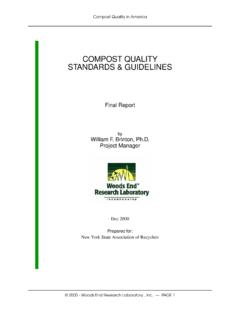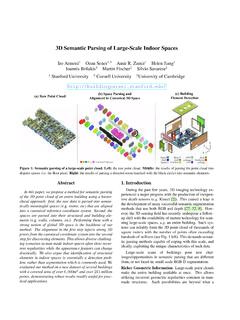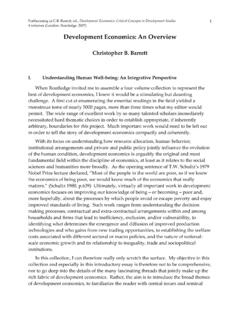Transcription of 1 THE SCIENCE OF COMPOSTING - Cornell University
1 1yTHESCIENCE OF COMPOSTINGIf moist food scraps are placed in a container and left to sit for a weekortwo, the end product is likely to be a smelly slop that attracts the proper conditions, these same food scraps can be composted toproduce a material that looks and smells like rich soil and can be used toenhance soil texture and productivity. So, what are these conditions thatpromote COMPOSTING ? The physical and chemical conditions that should be maintained in acompost heap seem logical if you think about what compost really is abig pile of food for billions of minute organisms. These microorganismshave certain chemical requirements, primarily carbon for energy, nitro-gen to build proteins, and oxygen for respiration. Interacting with theseare physical requirements, such as aeration to maintain optimal oxygenlevels while not depleting the moisture necessary for microbial growth.
2 This chapter begins with an overview of the chemical, physical, andbiological changes that occur during thermophilic COMPOSTING , therebyproviding an example of how several sciences can be integrated in thestudy of COMPOSTING . This overview is followed by more detailed, separatesections on compost chemistry, physics, and biology. Much of the infor-mation in the chemistry and physics sections focuses on thermophiliccomposting. The biology section includes a discussion of the microbesthat are present in all types of COMPOSTING , and of the diversity of inver-tebrates that live in outdoor and some worm COMPOSTING information presented here reflects the current body of scientificknowledge regarding COMPOSTING . Much remains unknown, leaving avariety of intriguing questions for future research.
3 Some of these ques-tions are identified as Research Possibilities, sprinkled in italics through-out the text. We hope they will provide the inspiration for students toask a much wider range of questions, and to design their own COMPOSTINGMany COMPOSTING systems are based on providing the optimal condi-tions for thermophilic COMPOSTING because its high temperatures pro-mote rapid decomposition and kill weed seeds and disease-causingorganisms. These high temperatures are a by-product of the intensemicrobial activity that occurs in thermophilic COMPOSTING . Thermophiliccomposting can be divided into three phases, based on the temperatureof the pile: (1) a mesophilic, or moderate-temperature phase (up to 40 C),which typically lasts for a couple of days; (2) a thermophilic, or high-temperature phase (over 40 C), which can last from a few days to severalmonths depending on the size of the system and the composition of theingredients; and (3) a several-month mesophilic curing or maturationphase.
4 Periodic temperature measurements can be used to chart theprogress of thermophilic COMPOSTING , producing a temperature profile showing these three phases (Figure 1 1).SCOMPOSTING IN THE CLASSROOM 26050403020103691215182124273033rapidupt ake ofsolublesugarsandstarchesexplosivegrowt h ofmesophilicbacteriaand fungiTIME(days)THERMOPHILIC PHASE (> 40 C)MESOPHILIC PHASE (10 40 C)MESOPHILIC PHASE (10 40 C)TEMPERATURE( C)mixed population of thermophilicbacteria and actinomycetes, and themost heat-tolerant fungimesophilic actinomycetes, other bacteria,and fungi predominate, invertebrates colonize outdoor pilesbreakdown of proteins,fats, hemicellulose, andcelluloselong, slow degradation of lignin andother highly resistant compounds, andformation of resistant organic mixturecalled humusFigure 1 1.
5 The Three Phases of Thermophilic communities of microorganisms predominate during thevarious temperature phases. Initial decomposition is carried out by meso-philic microorganisms, those that thrive at moderate temperatures. Thesemicrobes rapidly break down the soluble, readily degradable compounds,and the heat they produce causes the compost temperature to rapidlyrise. Once temperatures exceed 40 C, the mesophilic microorganismsbecome less competitive and are replaced by thermophilic, or heat-lovingmicrobes. During the thermophilic stage, high temperatures acceleratethe breakdown of proteins, fats, and complex carbohydrates like celluloseand hemicellulose, the major structural molecules in plants. As the sup-ply of these compounds becomes exhausted, the compost temperaturegradually decreases and mesophilic microorganisms once again take overfor the final phase of curing, or maturation of the remaining organicmatter.
6 Although the compost temperature is close to ambient during thecuring phase, chemical reactions continue to occur that make theremaining organic matter more stable and suitable for plant smaller systems used for indoor COMPOSTING are not likely to getashot as compost in large piles or windrows. A well-designed indoorcompost system, >10 gallons in volume, will heat up to 40 50 C in thefirst two or three days. Soda bottle bioreactors, because they are so small,are more likely to peak at temperatures of 40 45 C. At the other end ofthe scale , commercial or municipal- scale compost systems may reachtemperatures above 60 C. Because temperatures above 55 C are lethal tomany microorganisms that cause human or plant diseases, this is thetarget temperature that compost managers use for suppression of patho-gens.
7 However, if the compost temperature goes above 60 65 C, the ben-eficial microbial populations are also killed. Humans can control the temperatures during COMPOSTING by mixingor turning the organic materials (Figure 1 2). If the pile or windrow isgetting too hot, turning a pile can release heat from the inner core,which temporarily cools it down (points A and B in Figure 1 2). As thefood available to thermophilic organisms becomes depleted, their rate ofgrowth slows and the temperature begins to drop. Turning the pile at thispoint may produce a new temperature peak (points C and D in Figure1 2). This is because relatively undecomposed organic matter gets mixedinto the center of the pile, where temperature and moisture conditionsare optimal for rapid decomposition. In addition, mixing loosens up thecompost ingredients, which increases the infiltration of oxygen that isneeded by aerobic microorganisms.
8 After the thermophilic phase is com-pleted, the compost temperature drops, and it is not restored by turningor mixing (point E).1 THE SCIENCE OF COMPOSTING T3 Figure 1 2. The Effects of Turning on compost Temperature. (See for explanation.)Research Possibility:Garden supply stores and catalogs often sell compost starters, which they claim speed up the COMPOSTING process. Develop a recipefor a compost starter and design a research project to test its effect on the com-post temperature profile. (Hint: You might want to include finished compost orsoil as an inoculant, or nitrogen fertilizer or sugar to trigger fast microbialgrowth.)SCOMPOSTING IN THE CLASSROOM 4 TEMPERATURE( C)TIME(days)1070605040302010A2030405060 BCDE6 compost CHEMISTRYMany chemical changes occur during COMPOSTING , either relativelyrapidly in thermophilic systems or more slowly in worm bins or othersystems that do not heat up (Figure 1 3).
9 In all of these compost systems,chemical breakdown is triggered by the action of enzymes produced bymicroorganisms. Bacteria and fungi secrete enzymes that break downcomplex organic compounds, and then they absorb the simpler com-pounds into their cells. The enzymes catalyze reactions in which sugars,starches, proteins, and other organic compounds are oxidized, ultimatelyproducing carbon dioxide, water, energy, and compounds resistant tofurther decomposition. The enzymes are specialized, such as cellulase tobreak down cellulose, amylase for starches, and protease for proteins. Themore complex the original molecule, the more extensive the enzyme sys-tem required to break it down. Lignins, large polymers that cement cellu-lose fibers together in wood, are among the slowest compounds todecompose because their complex structure is highly resistant to organic matter decomposes, nutrients such as nitrogen, phosphorus,and potassium are released and recycled in various chemical formsthrough the microorganisms and invertebrates that make up the compostfood web.
10 Proteins decompose into amino acids such as glycine or cys-teine. These nitrogen- and sulfur-containing compounds then furtherdecompose, yielding simple inorganic ions such as ammonium (NH4+),nitrate (NO3-), and sulfate (SO42-) that become available for uptake byplants or all compounds get fully broken down into simple ions. Microbesalso link some of the chemical breakdown products together into long,intricate chains called polymers. These resist further decomposition andbecome part of the complex organic mixture called humus, the end prod-uct of thermophilic COMPOSTING , any soluble sugars in the original mixtureare almost immediately taken up by bacteria and other resulting explosive microbial growth causes the temperature to the thermophilic phase, more complex compounds such as pro-teins, fats, and cellulose get broken down by heat-tolerant , these compounds become depleted, the temperature drops,and the long process of maturation begins.











